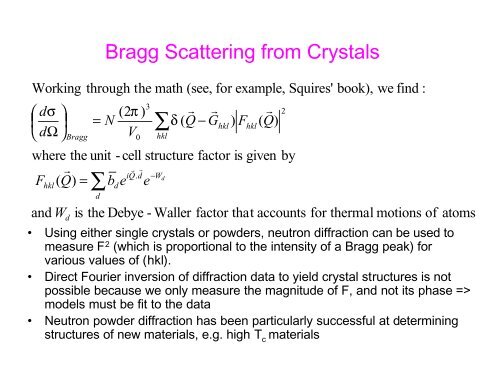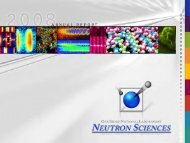An Introduction to Neutron Scattering - Spallation Neutron Source
An Introduction to Neutron Scattering - Spallation Neutron Source
An Introduction to Neutron Scattering - Spallation Neutron Source
You also want an ePaper? Increase the reach of your titles
YUMPU automatically turns print PDFs into web optimized ePapers that Google loves.
Working<br />
⎛ dσ<br />
⎞<br />
⎜ ⎟<br />
⎝ dΩ<br />
⎠<br />
and W<br />
is<br />
Bragg <strong>Scattering</strong> from Crystals<br />
through the<br />
( 2π<br />
)<br />
V<br />
where the unit - cell structure fac<strong>to</strong>r<br />
r<br />
r r<br />
iQ.<br />
d −Wd<br />
F ( Q)<br />
= b e e<br />
hkl<br />
Bragg<br />
d<br />
=<br />
∑<br />
d<br />
N<br />
d<br />
0<br />
the Debye - Waller<br />
3<br />
math (see, for example, Squires' book), we find :<br />
r r<br />
δ ( Q − G ) F<br />
r 2<br />
( Q)<br />
∑<br />
hkl<br />
hkl<br />
is<br />
hkl<br />
fac<strong>to</strong>r that<br />
given<br />
accounts<br />
for thermal<br />
motions<br />
a<strong>to</strong>ms<br />
• Using either single crystals or powders, neutron diffraction can be used <strong>to</strong><br />
measure F 2 (which is proportional <strong>to</strong> the intensity of a Bragg peak) for<br />
various values of (hkl).<br />
• Direct Fourier inversion of diffraction data <strong>to</strong> yield crystal structures is not<br />
possible because we only measure the magnitude of F, and not its phase =><br />
models must be fit <strong>to</strong> the data<br />
• <strong>Neutron</strong> powder diffraction has been particularly successful at determining<br />
structures of new materials, e.g. high T c materials<br />
by<br />
of
















